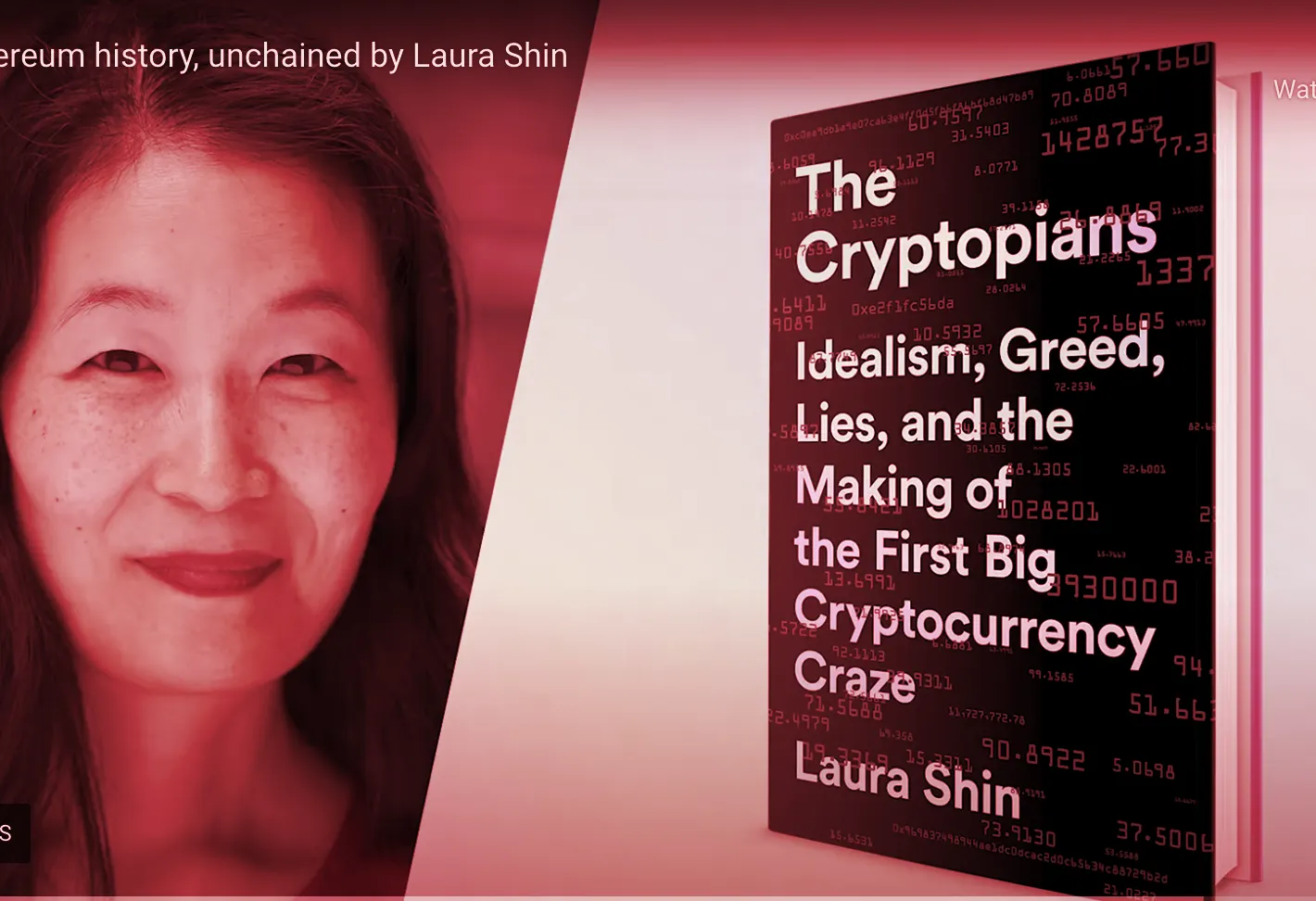In brief
- Shin reveals new details about Vitalik and other early Ethereum figures.
- The book has gossip about the Ethereum Foundation and the founders of Cardano and Polkadot.
In a list of the most important new technologies of the 21st century, Ethereum should be near the top. Since launching in 2015 as a more versatile form of Bitcoin, the blockchain and its smart contracts have transformed finance, computing, and online governance—and spawned a colorful culture of visionaries, entrepreneurs, and hackers.
Given Ethereum’s enormous impact, it’s helpful to know who made it and why. A new book, The Cryptopians: Idealism, Greed, Lies and the Making of the First Big Cryptocurrency Craze, goes a long way in telling us. This isn't the first book on Ethereum but, thanks to author Laura Shin’s meticulous research and deep crypto pedigree, it's the most authoritative.
Shin, a one-time Forbes journalist and host of the influential Unchained podcast, covered the early days of Bitcoin and is deeply sourced in the different tribes that make up the world of blockchain. For her dive into Ethereum, she hopscotched the globe—visiting Switzerland, Singapore, San Francisco and other crypto meccas—to uncover its origin story and that of its boy genius founder, Vitalik Buterin (known to everyone in crypto simply as Vitalik).
The broad strokes of Vitalik’s background are well-known: a precocious child raised in Toronto by Russian emigrés, he survived an awkward adolescence by finding community in the online world of cryptocurrency. He founded an influential Bitcoin publication while still in high school, and soon after published what would become known as the Ethereum white paper at the age of 19. That work, along with Satoshi Nakamoto’s Bitcoin 2008 white paper, are the foundational documents of today’s multi-trillion dollar crypto economy.
The Cryptopians reveals how Vitalik’s genius and innate altruism helped him overcome a total lack of social skills, and build a world-changing blockchain alongside a motley collection of geeks, grifters, and hangers-on. The task was not easy. While strife is part of every startup's story, the book describes extraordinary infighting at Ethereum, culminating in a “Game of Thrones” day in Zug, Switzerland, that saw the project emerge with eight co-founders who remain outsize crypto figures to this day.
A lot of what follows in The Cryptopians is deeply inside baseball, though likely to tickle crypto fans in the same way that Nick Bilton’s backstab-fest Hatching Twitter titillated Silicon Valley. Shin digs up new dirt on the Ethereum co-founders, all of whom made legitimate contributions to the new blockchain, but often proved incapable of sharing credit. Those include Charles Hoskinson and Gavin Wood, who emerge as the chief villains in the early Ethereum story. Shin supplies anecdotes that depict Hoskinson, who today runs Ethereum rival Cardano, as a pervert and pathological liar. Meanwhile, Wood comes across as a failed MacBeth, forever trying to knife anyone in his path, including Vitalik, even as his own projects founder due to security concerns and Wood’s colossal ego.
While Shin exposes the bad behavior of blowhards like Hoskinson and Wood, she also takes care to credit the role of the the legions of little known individuals who make up the "community"—and whose selfless and often anonymous contributions make them the real heroes of the Ethereum story.
A good portion of The Cryptopians is devoted to the so-called DAO wars, which began with the creation of the first decentralized autonomous organization on Ethereum. This original DAO was an investment collective whose funds were governed entirely by code—and (surprise!) promptly got hacked. The hack posed an existential moment for early Ethereum as the young community had to decide whether to orchestrate a “hard fork” to overwrite its supposed immutable blockchain so as to recover the stolen funds. Ultimately, the majority of the Ethereum community chose to go forward with the fork even as a minority of purists (and the thief) complained it transgressed the “code is law” ethos that's supposed to rule the crypto world.
The story of the DAO wars—which involved a further series of hacks and counter-hacks—is also described in Camila Russo’s worthy The Infinite Machine, another Ethereum history published in 2020. Russo’s account covers much of the same ground with a lighter touch, though in less comprehensive fashion.
Shin’s telling of this part of Ethereum’s history is exhaustive, providing exhaustive details that often include the precise time and blockchain transaction record of each twist and turn. This means the tale can feel eye-glazing at times, but Shin’s thoroughness makes the account highly trustworthy—an important attribute given that many key Ethereum figures operate under cloaks of anonymity.
The book frequently adopts the argot of the crypto scene (“multisigs,” “maximalists,” and so on), and includes numerous technical descriptions. This means The Cryptonians is not an ideal choice for crypto newbies—Nathaniel Popper’s Digital Gold or The Age of Cryptocurrency by Mike Casey and Paul Vigna are better for beginners—but those already familiar with blockchains will savor Shin’s insider angles and tech savvy.
The later sections of The Cryptopians cover the crazy period of Ethereum’s adolescence in 2017, a time marked by the first mainstream crypto boom, “initial coin offerings,” and legions of scams. These accounts are full of gossipy tidbits. For instance, Shin gets the tea on the rogue exchange Poloniex, whose sociopath founders terrorized their own employees while violating anti-money laundering laws, and uncovers ayahuasca-fueled foibles at the Ethereum incubator Consensys.
The juiciest drama surrounds the Ethereum Foundation, a nonprofit created during the blockchain’s early days and run by an unstable loony toon named Ming Chan. Shin reveals how Chan ran roughshod over the foundation’s staff while imagining conspiracies around every corner. The book also provides evidence of how Chan, who's more than twice Vitalik’s age, exercised a cult-like influence over the young Ethereum founder—an influence that bordered on romantic at times. (Vitalik, we learn, shares the same “Asian woman” fetish as numerous other prominent crypto figures).
The denouement of The Cryptonians involves Vitalik finally finding the nerve to wrest control of the Ethereum Foundation away from Chan, and learning to recognize his true friends among the legions of opportunists and hangers on seeking to manipulate him. Shin’s portrayal of Vitalik is one of the book’s greatest strengths, and comes at a time when the young man—today he's just 28—is emerging as one of the most important public intellectuals of our time.
In the last few years, the polyglot Vitalik (whose tongues include Chinese and Russian) has published foundational essays on topics as diverse as economics, governance, cyber-security, and geo-politics. Most recently, his voice has rallied the crypto world to support Ukraine in the face of Russia’s savage invasion. It’s a safe bet that Vitalik, like the economists Keynes and Marx before him, will be the subject of scholarly biographies and that Shin’s book will serve as an important resource.
More broadly, the book will provide new grist for what to make of the “Cryptopians” themselves—this new class of globe-trotting blockchain tribes, many of whom are billionaires and flexing their influence in leading political and cultural circles. As they become more prominent, they will become more scrutinized. Specifically, the time has come to ask whether the people behind Ethereum and other blockchains will deliver on their grandiose promises of freedom and democracy—or whether their rhetoric is simply a cloak for greed and self-interest.
While Shin’s book provides insights to consider such questions, its greatest value lies in its comprehensive account of how the world-changing technology known as Ethereum came to be. There will be dozens more books about crypto in the coming years, but Shin has written the definitive one on early Ethereum.

